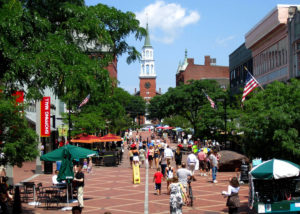Sounds a lot like Burlington…
by Jacob S. Knabb, Commercial Communications & Services Associate, National Association of REALTORS®
The retail sector occupies a huge part of the U.S. economy, directly affecting office, industrial, land, and multifamily sectors of the commercial real estate market. According to The International Council of Shopping Centers (ICSC), 1-in-11 jobs are related to shopping centers and retail is the largest employer in more than half the states in the U.S.
The question of whether e-commerce is hurting local retail or if the economic recovery following the housing crisis in 2008 is happening quickly enough is one that has broad- reaching implications for REALTORS® all over the country.
According to the U.S. Census Bureau, “e-commerce sales in the third quarter of 2016 accounted for 8.4% of total sales,” up 15.7% YoY, while retail overall is seeing sluggish growth, up only 2.2% YoY. This decade-long surge in e-commerce has altered the retail landscape, generating discussion and concern about the future of the industry. In other words, the rise of e-commerce has rattled retail.
Amid all of this turbulence, it is important to remember that e-commerce may be growing at a faster clip than traditional retail but it still comprises a small slice of the whole pie. Shifts from brick-and-mortar locations to online vendors, the rise of omnichannel approaches, the desire to find the lowest price at any cost, and heightened customer expectations for delivery at the speed of Amazon Prime have forced innovation and led to downsizing for traditional bulwarks like Macy’s and JC Penney’s. Can brick-and-mortar weather these transitions?
A Good Blend of Bricks and Clicks
“Retail is very healthy,” says Tom McGee, President and CEO of ICSC, citing net operating income for retail increasing 4.9% YoY 2016 from 2015 as an indication of a strong retail sector. He is confident the downsizing of traditional anchor stores is merely a sign of adaptation, not a cause for panic. “I go back to the 93% occupancy rates which indicates that the store closures over the past decade or so have been adjusted to by the landlord community in general.”
“The reality is that it’s brick and clicks,” says McGee. “More than 90% of sales still happen in a store. What you do find is that people use technology for research: to read reviews and check prices.” McGee notes today’s consumer favors omnichannel shopping experiences, which blend e-commerce with brick-and-mortar allowing engagement online, in-person, and on a smart phone.
There is industry enthusiasm about this blend of bricks and clicks and many are encouraged by the innovations beginning to materialize. “The idea that my phone can tell me where I am in a store and save me looking for a map,” McGee says “or push notify me of coupons and sales as I walk past stores, or recognize that I have purchased khakis at the Gap before and inform me about a new, blue color that is just out, is exciting.”
Tangible Goods and Service Providers
“E-commerce can’t paint your nails, cut your hair, or serve you a burrito,” says Travis Carter, CCIM. Carter feels there is a future for “brick-and-mortar,” though he sees changes in his Greensboro market because of e-commerce. “Consumers still need to see, touch, and feel those tangible goods,” Carter says, noting that the biggest change in retail can be seen through the dynamic of the shopping center tenant mix, which continues to shift towards businesses that provide services.
“You can walk into most any grocery-anchored shopping center in the southeast and find small shops filled with nail and hair salons, restaurants, fitness centers, insurance and investment offices, medical providers, and the list goes on.”
Heightened competition in the retail sector has raised the stakes, even for national chains. “Retailers have more real estate options and consumers have many more options in retailers.” The best learn to adapt and embrace change, to blend e-commerce with brick-and-mortar, enhancing the shopping experience for their clientele.
A Reason to Hit the Town on Friday Night
“Retail is about connecting and forming loyalty to consumers,” says Barbara Tria. “They connect with the core product and that builds loyalty to the brand.” Tria is excited about the innovations between merchants she is observing in her Miami market. Because of e-commerce, many local retailers have doubled down on engagement with their clientele, even partnering with other merchants in their trade areas, creating an exciting atmosphere of experiential retail.
“My core market is City of Coral Gables,” Tria says, “where the city is in the middle of a $20mm capital improvement project for Miracle Mile and the stretch of Giralda now known as “restaurant row.” The City of Coral Gables has been successful in engaging its property owners in a public- private blend for this project, including the expansion of sidewalks and the development of an overall design concept to evoke the clouds and sky on the Miracle Mile and to echo the look of a sandy beach on Giralda. “The plan allows the street to be closed off and the restaurant operators can expand seating to the beautiful outdoor setting,” Tria says. “Activating the street in this new way gives consumers an additional reason to go to Coral Gables.”
A lot of the initial growing pains associated with the shift towards mixed-use developments in markets can be attributed to developers who “had a mandate to have retail on the ground floor and at the time lacked the knowledge to deliver a retail-friendly box,” Tria argues. She strongly believes the current demand for experiential retail is well- matched to the retail renaissance in Coral Gables.
“Merchants are collaborating to fill spaces with unique experiences,” Tria notes, “and they might form a pop-up shop and work with like-minded landlords to craft an overall experience. It adds to the community and has paid off well.”
Retail Resilience in the Windy City
“A decade ago developers would do speculative projects in hopes that tenants would come along,” says Ken Robberechts, CCIM. “You don’t see that as much in Chicago now. In general, they communicate well with the community, organizations, and alderman in order to deliver the right tenant mix on a development. It’s about getting the community behind it and understanding what the community needs in order to bring a successful project to fruition.”
For Robberechts, brick-and-mortar is in a good place, especially the businesses that have adapted and thrived along with the rise of e-commerce. “I think the word broadly defined is resilience,” Robberechts argues. “You’re seeing resilience within the brick-and-mortar part of the industry.” Robberechts attributes this to the focus of developers and landlords on finding creative ways to service different types of tenants.
“There are significant mixed-use projects taking place. I see that growing, well into the next 5-10 years,” Robberechts says. “Where I see e-commerce really impacting retail is the inventory off of Main and Main. Those mom and pop type startups may not want to be in the middle of the block to test their proof of concept as e-commerce provides an alternative avenue. That is where you’re seeing landlords having to get more creative on vacant space.”
Rubbing Shoulders with Mom and Pop
“I don’t think it’s lip service to speak to the importance of experiential retail, says John Propp, CCIM. “I can see the pendulum swinging back away from everything happening online.” Propp’s Denver market is in the midst of a commercial real estate boom unlike anything he can remember. “There has to be some sort of a concern,” he says. “E-commerce has to be more than a passing fad. But I don’t think it’s an end to the mom and pop.”
Propp views the two as moving closer to omnichannel sales. He feels the last real impediment is the issue of sales tax. Purchases made online don’t typically include a state sales tax, a decision stemming back to a 1992 Supreme Court decision. “Once this is settled there will be even less conflict between the two. The percentage of sales from an LL Bean catalog was minute. Now we are seeing millions and millions of dollars in e-commerce sales. It usually doesn’t take that long for legislators to find tax dollars.”
At the End of the Day It’s Important to Work Together
While no one can see the future with precision, it is certain that continued evolution will occur. Anchor stores continue to change, pivoting from big-box retailers to smaller service providers, medical facilities, restaurants, and multi-unit residential. National chains are downsizing and refocusing on personalization, catering to more specific clientele rather than trying to be everything to everyone. Omnichannel approaches and experiential retail continue to take root in all facets of the market, from e-commerce giants like Zappos to boutique boot shops in Memphis. Still, reports of the death of traditional retail are greatly exaggerated. Across the country, REALTORS® are working with their clients to adapt and prosper as the industry reinvents itself.









